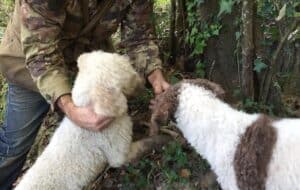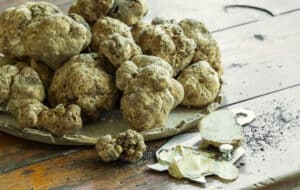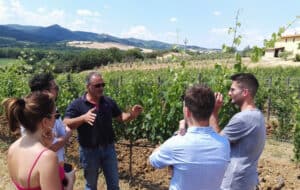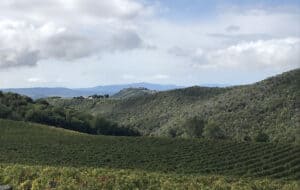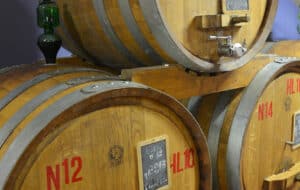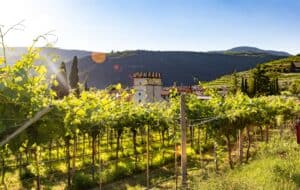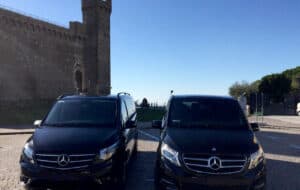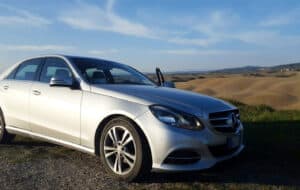The area southeast of Siena is called Crete Senesi. “Crete” means clay, which gives the typical grey color of this landscape. A lunar landscape is the only way you can describe this area: the dry grey terrain forms of badlands and clay knolls seem mostly bleak. In fact, in this part of Tuscany, you don’t often see vineyards and olive trees but mostly cultivated fields instead. This amazing phenomenon is just the result of eroding sediment from the Pliocene sea between 2.5 and 4.5 million years ago.
The impressive landscape is the main character of this territory, but there is no shortage of lovely towns (such as Asciano, Buonconvento, Serre di Rapolano, and San Giovanni d’Asso), of excellent food, truffle stands out above all the rest, of relaxation while enjoying the Rapolano hot springs, and of spirituality as well (the Abbey of Monte Oliveto Maggiore is not to be missed!).
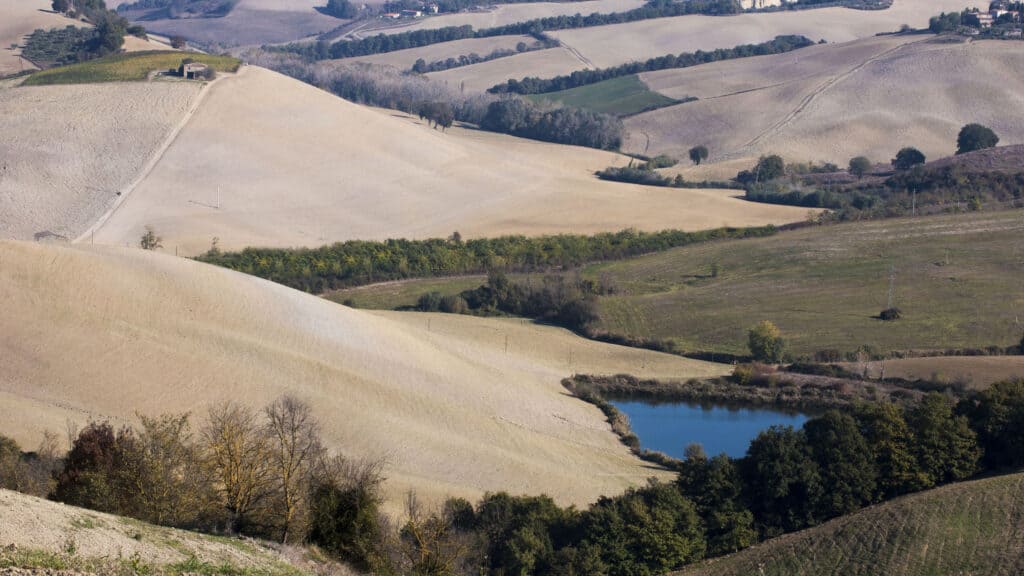
San Giovanni d’Asso
On top of a hill surrounded by protecting walls, San Giovanni d’Asso overlooks the area with its big castle which houses a hotel, a restaurant, and the “Truffle Museum“. The village is actually very famous for its white truffle. Every year there is a festival celebrating this rare and precious white jewel during the second and third weekend of November, an event that is not to be missed if you love white truffle.
Local restaurants are specialized in preparing all kinds of food using truffles from appetizers to desserts. Osteria delle Crete and La Locanda del Castello are the best. If tasting is not enough and you really want to understand everything about truffles (and have a lot of fun at the same time), a truffle hunt is the perfect experience!
Very close to the town there is a special place – a woodland park and garden created by American artist Sheppard Craige called ‘Bosco della Ragnaia‘. As you walk under big oak trees, you may find words and inscriptions here and there, open to different and very personal interpretations.
Monte Oliveto
Surrounded by lush vegetation, the Abbey was founded in 1313 by Sienese Bernardo Tolomei. This isolated place already belonged to his family, and he retired here after he converted to the Benedictine order, beginning the construction of the Abbey a few years later. What we can see today was finished during the following centuries.
You will feel beckoned into silence upon entering the Latin cross-shaped church. The interior of the church is always illuminated by rays of sunshine giving a warm welcome to those who enter. There are many works of art by several artists inside the Great Cloister, the church, and the surrounding rooms and buildings.
The church is older, but the interior was transformed in baroque style in the 18th century. The carved and inlaid wooden choir is a real masterpiece made by Fra Giovanni da Verona in 1503-1505 and one of the greatest examples of inlay work in the world. But the real attraction of the Abbey is definitely the 35 frescoes of the great cloister representing the life of St. Benedict, considered masterpieces of the Italian Renaissance. The first artist who started this enormous masterpiece was Luca Signorelli from 1497 to 1498 and then Antonio Bazzi, called Sodoma, who continued the paintings after 1505.
In the upper courtyard, there is a shop with souvenirs and some products from the farm of the Abbey such as herbal liqueurs made by the monks. The wine cellar below the cloister is also very interesting. In fact, it is well known that monks have been crucial in the production and improvement of wine and beer production techniques in past centuries.
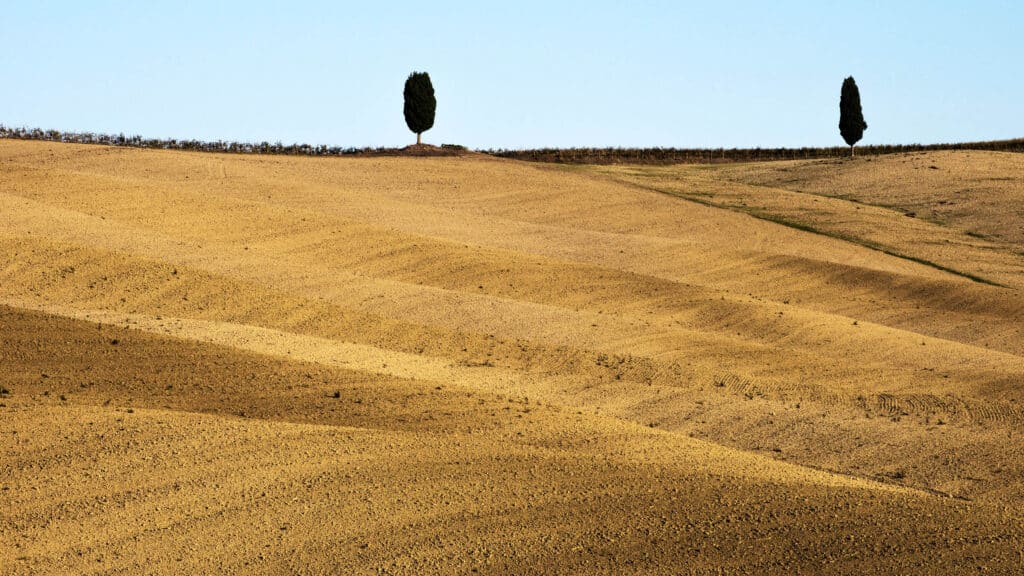
Asciano
Asciano has a lovely small historical center partly surrounded by medieval walls. At the lower end of the main street you will find the Etruscan and Sacred Art Museum, highly recommended if you are interested in archaeology as well as Etruscan and medieval art, since this small collection houses an excellent selection of attractive pieces.
If you happen to visit this small town on the second Sunday of September, you can enjoy a popular event called Palio dei Ciuchi, a donkey race in which the seven contradas of the village compete against each other.
On the main street there are two excellent restaurants for a lunch break: Amor Divino, popular for the famous Florentine steak cooked on an open fire in the middle of the dining room. The other is La Mencia with its gorgeous outside terrace in the summer serving superb traditional Tuscan dishes.
While in this area, you can’t miss out on visiting the landscape art Site Transitoire by French artist Jean-Paul Philippe, a beautiful sculpture in the middle of nowhere. From here you will be delighted by the really beautiful view of Siena. The best moment to enjoy this particular artwork and the surrounding landscape is for sure at sunset.
Rapolano Terme and Serre di Rapolano
Rapolano Terme is mostly famous for its hot springs where you can enjoy a relaxing day and take advantage of the beneficial effects of water. The natural thermal spring waters which fill pools in this area bubble up from their source at 39 degrees centigrade and are rich in sulphur and calcium bicarbonates. These mineral characteristics combined with the high temperature of the water, confer special properties which are especially effective in treating skin, breathing, and mobility issues. There are two spas in the village and both are excellent: Terme Antica Querciolaia and Terme San Giovanni (the sunset from the outdoor pool here is just magical!)
A small gem not far from here is Serre di Rapolano with its lovely historical center. The castle dominating the village is also an amazing hotel, Castello delle Serre. Sleeping here is just like living in a fairy tale! The perfect time of year to visit Serre di Rapolano is for sure May during the two weekends in the middle of the month when there is a traditional medieval spring festival called Serremaggio. It truly is a step back in time to life in the Middle Ages. All locals dress up in medieval costumes and the streets are crowded with craftsmen, farriers, carpenters, and blacksmiths at work. While minstrels and acrobats perform, you can taste medieval style food.
